Great interview and video of Pat Cohen, creator of incredible deer hair bugs. Check it out!

Great interview and video of Pat Cohen, creator of incredible deer hair bugs. Check it out!

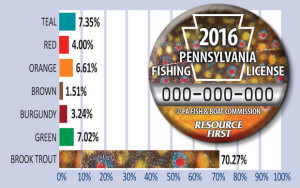 The Pennsylvania Fish and Boat Commission chose a brook trout pattern for their fishing license button. In fact, it won in a landslide.
The Pennsylvania Fish and Boat Commission chose a brook trout pattern for their fishing license button. In fact, it won in a landslide.
Of course, I don’t see any other fish patterns represented. If you’re up against green, red, brown… why would you not win if you were the color “brook trout”?
When exactly do brook trout spawn around here? While there is no alarm that rings and signals it is time, it does begin in the fall. Depending on where you get your information, in Virginia, that time may be here.
Mossy Creek Outfitters reports on October 21, 2015:
Many brook trout are paired up or have already spawned. This is a controversial topic and we respect informed anglers decisions to fish or give the brook trout a break. Our shop does not guide on brook trout water during this season nor do we actively fish mountain wild waters now through winter. We understand many responsible anglers enjoy this time of year in the mountains. We ask that anyone fishing please do your best to stay out of the creeks as much as possible to avoid stepping on redds or possibly coating fragile eggs with silt stirred up from wading. Return fish quickly to the stream and observe the pools for actively spawning fish and redds. Remember that brook trout eggs will incubate on the streambed for 45-140 days depending on water temps! This means you will need to be careful in these creeks until early March most years! Enjoy the colors in the mountains and the great fishing but please be cautious. We want to ensure a great spawn this season.
Murray’s Fly Shop two days earlier:
The brook trout are spawning now and most anglers believe it is best not to stress them by fishing for them even though we return them to the stream.
The Shenandoah National Park website:
Brook trout spawn in the fall, most typically from early October to mid November within park streams. Spawning is triggered by decreasing day length and water temperature. Shallow depressions know as redds are excavated by female brook trout on typically gravel substrates. Redds are initially defended by both sexes followed by abandonment upon the completion of spawning. Hatching typically commences during mid to late January within park streams and juvenile fish begin to vacate redds by mid March.
I was on the Rapidan last week and I did not see signs of fish spawning there yet. However, that was at lower elevation and in roughly the middle of the park. Farther north and higher up on the Blue Ridge, spawning is likely to be underway.
It’s good to be aware of all this, and if you do fish, try not to step in the stream when you don’t have to. And don’t be greedy. It is easy to spot brookies when they are sitting still in the current guarding their redds. Brook trout are under pressure in a ton of ways. Choosing to avoid fishing for them while they are spawning is a personal choice, but spawning is a critical time for them to successfully reproduce, so please go easy if you are out there.
A key question about native trout, posed in Angling Trade’s fall 2015 issue:
But do anglers really care? And, for an outfitter or guide, do native trout fisheries help pay the rent?
I’d say some anglers care, but many couldn’t care less about native trout.
I think native fish are gems. We are fools to ignore how significant it is that these creatures are still around, and in those few remaining places they’ve always been, despite the best efforts of mankind to fuck up nearly everything for them.
Greenback cutthroat on Colorado’s Front Range, Gila trout in New Mexico, Westslope cutthroat in Idaho and Montana, Yellowstone and Colorado River cutthroats in Wyoming, bull trout, native salmonids, and of course brook trout in the East all live in habitat under constant pressure from development, demand for water, pollution, and climate change. Things aren’t getting better overall. There are some pockets of improvement, and a few more areas that are holding steady, but mostly, it is a story of relentless decline for native trout.
Go read State of the Trout on Trout Unlimited’s website if you don’t believe it.
As always, it’s a question of what we value. It is great to read about some of the outfitters and anglers in the Angling Trade piece who value native fish, but it is certainly not the majority’s view in our society that we should preserve the places that support these species. If it were, we wouldn’t be reading articles like this.
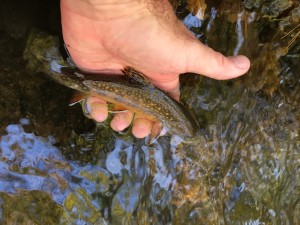
Great fall day! I went out yesterday intending to hit just the Rapidan River near and also within Shenandoah National Park. I turned this into a three-stream trip on a whim. Hitting three streams in one day is not my usual approach. The typical thing for me is to park on Skyline Drive, hike down below fishable water, fish upstream for a while, then hike back out. Always a workout. Today, it was all drive-by fishing.
The first detour was to one of the places I can catch decent brookies without hiking more than five minutes. Sure enough, I got the guy at the top of this post on a small Stimulator. That was good enough. I turned around and got back in the car, bound for the Rapidan.
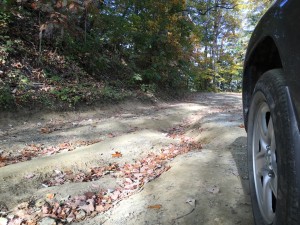
I haven’t fished the Rapidan in at least five years. It’s an odd place in the park, maybe the only stream where you can just about drive right up to all the good water and fish. Although “driving right up to the good water” makes it sound easy, see the photo — that’s a relatively mild section of the road. The road appears to be in much worse shape than when I was there years ago. And I suppose that’s a good thing. It probably keeps the fishing pressure a little lower than it would be otherwise. Despite the driving challenge, I did see a handful of cars and fishermen there. Maybe the VDGIF should drop a couple bombs and make it a little tougher still.
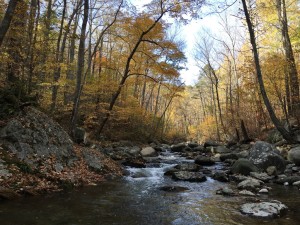
The fall colors are just past peak in the elevations, and there is lots of green in the valley. Overall, right now is probably peak color in the park. I suggest you avoid Skyline Drive this time of year. It is always crowded with gawkers and slow drivers in autumn.
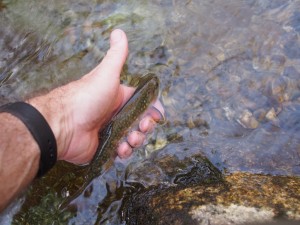
Fishing on the Rapidan was tougher than it should have been, all due to my fly selections. I tried Stimulators, Royal Wulffs, Mr. Rapidans, each with some success but lots of splashy refusals. What ended up really working, though, was a plain black foam beetle with a small orange square on top. I got the biggest fish on the Rapidan in a super shallow spot, at a moment when I was not expecting it. No photo of that one, sorry. Gotta remember (and I know this but am stubborn) — fall is a great time for terrestrials on brook trout streams.
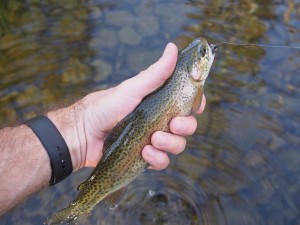
Heading out, I decided to fish the public stretch of the Rose River. I’ve always passed this by. Rose River Farm is right up the road and I have fished there twice. I was hoping that jumping in on the public section downstream of there would put me in contact with some of those big RRF trout that may have washed downstream. Well, that didn’t work out but I did get this one nice little rainbow.
Total stats for the day:
Yes, finally got a small leak in my cheapo LL Bean Emerger waders. Took a few years. Even though I try to be gentle on clothes, boots, and gear, these waders have seen more than their share of sliding down rocks, ripping through brambles, and other forms of assault. I’d give them high marks, especially considering the low price. Should be an easy patch job.
Anyway, beautiful fall brook trout fishing is going to wind down in the next couple weeks. Get out and enjoy the colors and the warm weather!
Data
Weather conditions: mostly sunny, winds SSW one to 7 mph
Air temp: 77
Water temp: unknown
Insect activity: none observed
Flies used: Stimulator, Royal Wulff, Mr. Rapidan
Great story about brook trout in the Coonamesset River on Cape Code back in May. Note that these are not sea-run brook trout. 
I really hate getting on the soapbox about environmental stuff. But… I really hate this crap even more.
Omega Protein Corporation, the company that has become expert at overfishing menhaden, the main forage species of saltwater gamefish on east coast, is an oozing sore. This article highlights just the latest problem with their operations. And the politicians in our state of Virginia are in the company’s pockets:
[Governor] McAuliffe, like many other public officials in Virginia, has benefited from Omega, receiving $25,000 in 2014 for the governor-elect’s inaugural committee, according to vpap.org. In all, the company has contributed $385,749 to the campaigns of Virginia candidates.
That matters because Virginia’s menhaden fishery is controlled by the General Assembly rather than by regulators, as all other saltwater fish are. Virginia is the only state on the Atlantic coast where lawmakers manage the menhaden fishery.
I have not read a single quote from a Virginia politician speaking out against this company. And no wonder, given how much Omega gives our lawmakers. Omega also spends quite a bit on lobbying. If I’m reading this page correctly (based on their methodology description), for the second quarter of 2014 the company spent $3.3 million on lobbying. That may not compare to, say, the pharmaceutical industry (which might spend ten times more), but it is not a small sum for a company that grinds up fish for nutritional, industrial and agricultural products.
These guys have also spent time on respectable activities like trying to change the science that determines how many menhaden are in the sea, threatening layoffs if menhaden quotas are limited, and almost comically, controlling the Executive Director of the Atlantic States Marine Fisheries Council like a puppet (read the whole article — all of it is startling).
Meanwhile, menhaden, The Most Important Fish in the Sea, are getting wiped out. The growing scarcity of this prime baitfish is a key factor in the long term decline in stocks of striped bass, bluefish and other predatory gamefish.
Omega Protein couldn’t give a rat’s ass.
So while this has nothing to do with brook trout directly, it is another example of how easy it is to decimate a fishery with nothing but greed. And that has happened throughout the entire range of the native trout of the East since our country was settled. Gluttonous exploitation is a sickness we humans come down with all the time.
Man, have I not posted anything since June 25th? That’s a shame. Trouble is, once the summer arrives the brook trout fishing in Virginia and parts slightly north of here really slows down. So I turn to other types of angling…
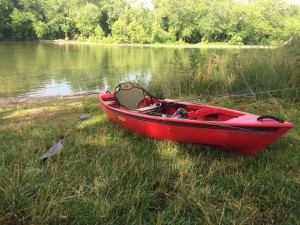 Much of my summer fishing was done from my new vessel, a Native Watercraft Ultimate 12. Not the new Ultimate FX, but the older model. Turns out that thing is more than good enough for what I do, which is tooling around the Shenandoah River trying to take smallmouth bass on a fly rod. The great thing about many of these new kayaks is that they allow you to stand up and cast… without tipping over! The Ultimate 12 does this so well. I can float down the river standing up and casting to the banks. I can stand up and sit down without dumping it. And I can even paddle the thing like it’s a stand up paddle board. There is not much I would really change about the Ultimate. It’s barely heavier than our Old Town Otter recreational kayaks, which are
Much of my summer fishing was done from my new vessel, a Native Watercraft Ultimate 12. Not the new Ultimate FX, but the older model. Turns out that thing is more than good enough for what I do, which is tooling around the Shenandoah River trying to take smallmouth bass on a fly rod. The great thing about many of these new kayaks is that they allow you to stand up and cast… without tipping over! The Ultimate 12 does this so well. I can float down the river standing up and casting to the banks. I can stand up and sit down without dumping it. And I can even paddle the thing like it’s a stand up paddle board. There is not much I would really change about the Ultimate. It’s barely heavier than our Old Town Otter recreational kayaks, which are
shorter and do not support standing up other than in a very comical sense.
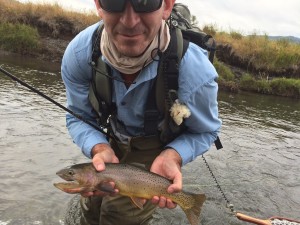 In August, my wife and I finally took an epic road trip that we’d been thinking about for years. Thanks to changes in our employment situations which now have each of us working as freelancers, we decided the time was nigh. We drove across the country — well, at least until we got to Wyoming. Then we stopped and stayed a couple weeks. The grand destination was Yellowstone National Park. We had other places on our hit list, too, including Madison, Wisconsin, the Badlands and Black Hills areas in South Dakota, Montana (just Montana, had to go there), the Grand Tetons, and Jackson Hole.
In August, my wife and I finally took an epic road trip that we’d been thinking about for years. Thanks to changes in our employment situations which now have each of us working as freelancers, we decided the time was nigh. We drove across the country — well, at least until we got to Wyoming. Then we stopped and stayed a couple weeks. The grand destination was Yellowstone National Park. We had other places on our hit list, too, including Madison, Wisconsin, the Badlands and Black Hills areas in South Dakota, Montana (just Montana, had to go there), the Grand Tetons, and Jackson Hole.
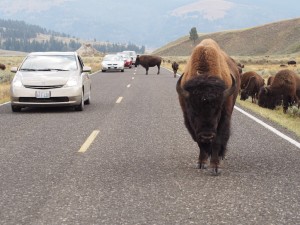 This was a road trip as much as a fishing trip, though I pushed and succeeded at twisting it a lot towards fishing. We fished in Yellowstone National Park, mostly in Soda Butte Creek, and also in Pebble Creek, Slough Creek, the Lamar River, and the Yellowstone River. Then we headed south to the Grand Tetons and Jackson, Wyoming, and fished the Snake River from the banks one day.
This was a road trip as much as a fishing trip, though I pushed and succeeded at twisting it a lot towards fishing. We fished in Yellowstone National Park, mostly in Soda Butte Creek, and also in Pebble Creek, Slough Creek, the Lamar River, and the Yellowstone River. Then we headed south to the Grand Tetons and Jackson, Wyoming, and fished the Snake River from the banks one day.
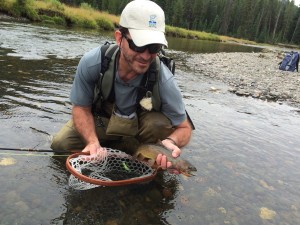
We caught quite a few very nice Yellowstone Cutthroats and some Snake River Fine Spotted Cutthroats. And in the Snake, I even found a few brook trout. It was all DIY fishing. Maybe next year, a guide and a float trip might be in the cards on the Snake.
So why am I posting something about fishing in the Bahamas on this blog about brook trout fishing? Because, like many fly fisherman, I am not restricted to a single type of fishing or a single species when I fish. One of the things I have enjoyed in recent years is going to the Bahamas to target bonefish. As many of you know, the Bahamian government has proposed new regulations aimed at fly fisherman who fish the flats (original document here). This could drastically change and likely end unguided fishing in the flats in that country.
My views on this are pretty simple. I have no problem with the idea of purchasing a fishing license to chase bonefish in the Bahamas. In fact, the first time I went there on a DIY trip, I asked the owner of the place we stayed where I needed to go to get a license. He laughed and said there is no need for a license to fly fish the flats in the Bahamas. I also discovered other aspects of these laid-back islands, such as no open container laws, and the rental car “agreement” was just handing over the cash and getting the keys to the car. This is part of the appeal of the out islands. Things are very informal. It’s nice. But as far as fishing licenses, again, I would gladly pay a reasonable amount.
So part of my problem with these draft fishing regulations is the proposed cost for unguided anglers to fish the flats. Aside from the one-time $10 application fee, it’s $20 per day. Several bloggers and commenters on their sites think that’s not unreasonable. I think it is. For a comparison, this past April I purchased an annual out-of-state saltwater license for Florida for a total of $49.97. That allows me to fish in Florida’s extensive saltwater fisheries for an entire year. In the Bahamas, that will pay for two days of fishing (including the application fee) under this proposal. Even Mexico charges about what Florida does for an annual license.
But it gets worse. Much worse…
See the regulations link above for yourself, but also read the following articles and you’ll see what is “between the lines” in this draft legislation:
Aside from restricting foreign ownership of lodges and participation in guiding, for the do-it-yourself angler, the process for obtaining a permit is vague and, based on what is written, troubling. In order to get a permit, the process appears to be controlled by fishing guides. In addition to the government possibly issuing permits (it’s unclear), the draft mentions that lodges and guides will issue permits (this is clear), and further, those lodges and guides can restrict access to areas where unguided anglers are allowed to fish.
So will one be able to go online and get a permit to fish anywhere in the Bahamas (which would be fine), or will fly fisherman have to get a permit for specific areas to fish on the island you’re visiting as allowed by a local guide who presumably oversees that area and has discretion to grant or deny it based on conditions he deems appropriate? Such as not letting you fish in or near an area he would like for his own operations? See here:
Section 4 (6) (c). A permit may be granted subject to such conditions, restrictions or limitations as the grantor considers appropriate.
And what is the penalty for violation? “Summary conviction,” which can be up to three months in prison and a $3,000 fine. In other words, no trial. You can be arrested on-the-spot and, worst case, hauled off to jail for three months. Nice.
From what I’ve read, it sounds like a contingent of Bahamian lodge owners and guides have gotten together and lobbied the government for this, and the practical effect is going to be a ban on unguided fishing throughout the islands. Not a good thing, and hopefully this is a bad interpretation of what is being proposed and it does not come to pass. But the way it’s written and, more importantly, the way people who are familiar with the fishing industry in the Bahamas see it (links above), a ban on unguided fishing is exactly what is being proposed.
Send your comments by Friday, June 26th 2015 to fisheries@bahams.gov.bs and primeminister@bahamas.gov.bs.
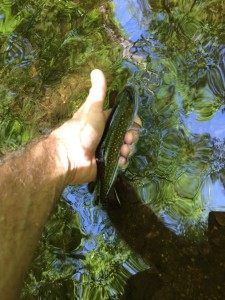
The George Washington National Forest is a fragmented collection of woodland areas in the western part of Virginia that stretch into West Virginia and Kentucky. There are lots of great trails and camping spots, and of course I am of the mind that those exist in order to access the freestone streams holding brook trout. So in mid-May I scoured Google Earth looking for some likely spots to fish not too far from home in the GWNF. This one in particular was not a stream I would go out of my way to fish again, but I’ve been here twice now and have seen and caught some decent brookies…
I hiked to the first pool and thought maybe I should try it. But it was right next to the trail, maybe a ten minute walk from where I parked. I figured there was just no way anyone had left a fish in there, and no way one had managed to elude even the few fly fisherman who pass by. And to have grown to a decent size, any fish that had managed to survive would have had to do it for a couple years, then either leap up a few small falls or bash its way down from the bigger rocky cliff just upstream in order to sit in this spot and survive. It didn’t seem likely. Thought I should just skip it.
Then… revelation. What the hell, why pass by any pool that looks like it may be good enough to hold a fish? I have passed by so many similarly marginal-looking spots before. Maybe I have been denied some record for the number of trout I’ve caught by skipping past these exposed pools. Probably missed some citation-sized leviathans, too. Right?
So I gave it a go. I do what I usually do in these small stream prospecting situations; tie on a size 14 Royal Wulff. Or was it a size 12? Doesn’t matter. Slathered it with some floatant, greased up the leader and sharpened the hook. Lowering the rod and myself, I crawled to the pool, trying to find shade and keeping my shadow far away from the water when I couldn’t. Even more likely that this spot had been fished out owed to the perfect lie of it. This stair-step run bent northeast just enough so that the midday sun couldn’t quite draw my silhouette on the water. Surely someone had depleted it.
First cast to the glassy tail of the small basin of water with just the leader out of the guides. The fly sat, then began its drift so slowly downstream, sitting upright like a newly hatched bug. Nothing. Second cast to the bubbling current in the middle, along the edge closest to me. Nothing. I kept working the fly a little further out and upstream each time I threw it, and raised the rod tip to keep the entire leader off the water and the fly drifting freely. About a half dozen casts in and I hooked him. Beautiful seven inch brook trout.
And that was it. Every other spot, especially the hard to reach little gorges and snaky looking banks… Nothing.
Go figure.